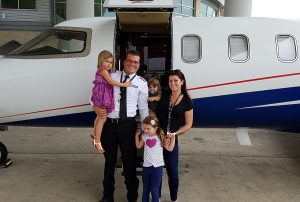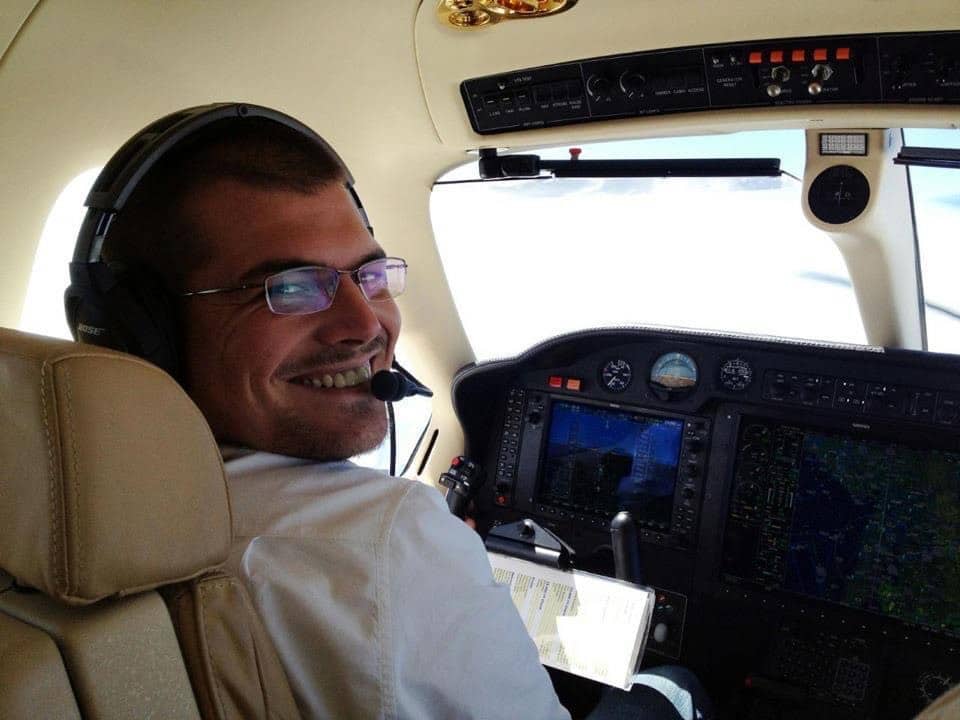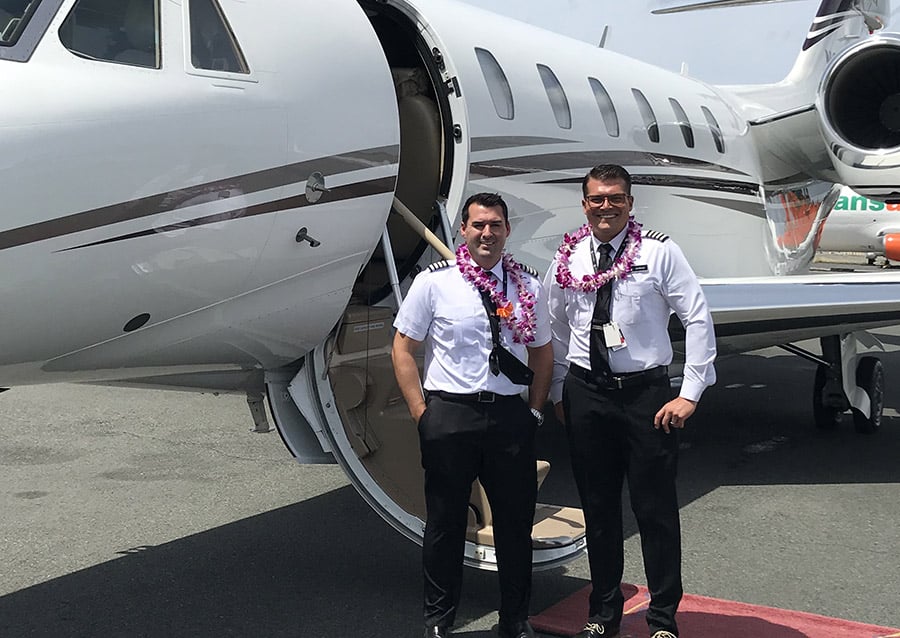Interview with an Aviator: Jeff Kircher
As a child in a military family, Jet Linx Houston Base Chief Pilot Jeff Kircher grew up near air bases and would often see planes flying overhead.
He can’t pinpoint when the aviation bug bit him, but it may have been one of the thousand times he watched Top Gun in his youth.
Kircher’s first job in aviation was performing operations at a local airport. In that position, he did everything he could to learn and gain experience – from volunteering to polish windows and clean oil spills to plowing snow. His hard work was eventually noticed, and he took a job flying a Cirrus up and down the Eastern seaboard.
Prior to joining Jet Linx, Kircher had actually made the decision to pivot from piloting to enter the business world. While running his own company in Texas, he caught wind of an opportunity at Your Personal Jet Company, and soon found himself back in the cockpit, flying to destinations like Mexico, Hawaii and Alaska.
After working his way up the ranks, Kircher was promoted to Houston Base Chief Pilot. As a Base Chief Pilot, he still flies regularly but also serves as a problem-solver and communicator while managing pilots in Houston. On top of his flight duties, Kircher also acts as a Jet Linx Ambassador, where he assists with recruiting, interviewing and hiring pilots.
Keep reading to learn more about what Jeff loves about working at Jet Linx, and what advice he has for young aviators!

A newly-promoted Lear 45 Captain Jeff Kircher with his family, Ava, Piper, Wyatt, and wife Kirsten in 2016 at Houston Executive Airport.
WHEN DID YOUR INTEREST IN AVIATION BEGIN?
Ever since I can remember, I was fascinated by aviation. As a child, I would thumb through any aviation magazine that I could get my hands on, and watch any movie with airplanes, like Top Gun (I’ve seen it about 1,000 times!). I also started to make cardboard cockpits with cutouts from the magazines and spent hours pretending to fly in them.
As the son of a military drill instructor, we lived near military bases growing up. There were five kids, so our parents would take us to air shows to pass the time. While all the kids enjoyed those air shows, I particularly loved them. Back then there were no noise or pollution restrictions, so the planes were extremely loud and would kick up big clouds of black smoke. As a kid, that was impressive to see. But the fact that there were always planes flying above me, continuously capturing my interest, I think that played a role in me becoming a pilot.
WHAT DO YOU LIKE MOST ABOUT BEING A PILOT?
We’re responsible for so many things and I enjoy taking charge of those tasks. When I go to work, I’m proud to put on the uniform and be a representative of Jet Linx. It’s also amazing to be up in the clouds going 600 miles per hour – there’s nothing quite like it and few people have the privilege of experiencing it. It’s indescribable.
I also have a wife and four children, and while the lifestyle can be difficult for some, we really have no issues. When I come home, that time together is much more special and intentional. You really learn to appreciate the time, as opposed to working 9-to-5 and only having the weekend. When I’m home, if we want to go out and do something, we’re going at off-times so there will be less crowds, which means my family and I get a little more intimate experience. There are a lot of benefits to the lifestyle, and we’ve made it work.
CAN YOU DESCRIBE YOUR CAREER PATH BEFORE COMING TO JET LINX?
I started flight training while in high school at the age of 16 when attending Valley Forge Military Academy in Philadelphia, PA. I probably amassed about 20 hours during high school and flew solo the first time at 17. I continued my flight training at a small local airport in Blue Bell, PA. While training, I wanted to learn more about the operations of the airport and started to help out in between my lessons. I did everything I could, from polishing planes to cleaning fuel – you name it. I really just wanted to be noticed as someone that was committed and eager to learn about every aspect of aviation.
My first professional aviation job was at the local airport performing airport operations and fueling aircraft for the small FBO at the field. I started meeting other pilots at the airfield which led to some flying opportunities for aircraft owners in their Cirrus aircraft. I would fly those aircraft all over the Eastern United States and Canada. I learned a lot about myself and my abilities, flying into everything from large complex airports to grass strips that were 2,500-feet long. I was able to start contracting in a Socata TBM 800, which was my first turbine aircraft. I can remember thinking to myself the first time leveling off at 31,000 feet that this was the highest that I have flown and I was so proud of myself.
When I had the required minimums and training, I left for the regional airlines to get a solid foundation for my ultimate career goal of flying corporate aviation. I started at Republic Airways, not having flown a jet aircraft before. This is a big transition for anybody, but mixing in airline operations into the training makes it very difficult. We would spend eight hours per day in class learning aircraft systems and company procedures. When classes were over for the day, we would get into study groups for a few hours every night. Initial training for the airlines usually lasts about one to three months depending on simulator scheduling. After training, we would be assigned a base across the country. I was assigned to the Embraer 190 doing supplemental charter lift for Caesars Entertainment and Republic Airlines. When I transferred out of Atlantic City, I moved to the Embraer 175 aircraft flying for U.S. Airways out of Philadelphia. I spent four years flying all over the U.S. Airways network on their commuter routes while looking for the transition back into business aviation. The commuter network grind left me somewhat burnt out. There was a lot of travel and few nights at home. I was ready to hang up my hat and enter the corporate world. But then a friend of mine mentioned working for Jet Linx.
WHAT ARE YOU MOST PROUD OF IN YOUR CAREER TO DATE?
Earning my Airline Transport License in 2013 was a defining moment. When I went to the airlines, I didn’t have any jet time and all I had was my commercial license. However, I knew I’d be force-fed all the necessary information and I was eager to advance. It was an intense three months of training, and when I finished, the sense of accomplishment was overwhelming. That dedication and commitment helped me get to where I am today.
WHAT IS YOUR FAVORITE PART ABOUT WORKING FOR JET LINX?
My favorite part is the ability to experience the destinations when the time permits. Our customers take us to some pretty amazing destinations across the world and go to some pretty amazing events. I always look forward to experiencing a destination and exploring the local spots. I just flew back from Mexico the other day, so I don’t ever complain about the destinations!

HOW HAS YOUR ROLE EVOLVED AT JET LINX?
I had actually left aviation altogether when I left Republic Airways. I was tired of commuting and the tedious schedules, but I did know I wanted to get back into corporate aviation someday. Then one day, a friend of mine knew someone working for Jet Linx and recommended the company to me. I did some research and liked what I saw. Next thing I knew, I was a Lear 40 First Officer for Jet Linx Houston. I was promoted to Captain in the Lear 40 and soon after became the Safety Officer for the Houston Base. I then moved to the Citation X in 2017 as First Officer and also moved to Assistant Base Chief Pilot. When my Base Chief Pilot left the company, I became the Captain on the Citation X and also the Base Chief Pilot for Houston.
As the Base Chief Pilot in Houston, I assist with recruiting and hiring, and also act as a liaison between Houston and the Jet Linx National Operations Center. If my pilots need help or have issues, I’m the one to help them, or seek further help up the ladder. My duties include managing schedules, resolving personnel or logistical issues, and maintaining extensive knowledge of all the aircraft at the Houston Base. I also fly the busiest aircraft at the Base, averaging about 40 to 60 flight hours per month. However, that time on the road allows me to focus on my administrative duties as Base Chief Pilot, and allows me uninterrupted time to assist my team members in Houston.
WHAT IS YOUR FAVORITE ASPECT IN THE JET LINX CULTURE?
I believe that the Supply the High-5 mantra is what sets Jet Linx apart and gives individuals a chance to lift one another up while giving our members the best experience. It unifies us as a company to support one another to achieve our goals individually as well as a whole.
WHAT ABOUT THE JET LINX SAFETY CULTURE?
I think it’s truly above all others. We do take a hyper-focus on safety and never ask our pilots to do more than what we deem to be safe. Jet Linx is also the only place I have worked where there is a dedicated Director of Safety. I have never had an experience with any company where they hire someone specifically dedicated to safety, so it’s a pretty amazing safety net for pilots and ground crews.
WHAT TYPES OF AIRCRAFT HAVE YOU FLOWN?
During my initial flight training, I flew many of the smaller Cessna aircraft as well as a Diamond Katana. I also flew a variety of Piper aircraft from the Archer to the Navajo. I’ve also flown all models of the Cirrus aircraft line – SR20, SR22, SR22T – as well as the Daher Socata 800 single-engine turbine, prior to the airlines. During my time at the regional airlines, I flew the Embraer 190, 170, and the 175. During my time at Jet Linx, I have flown the Lear 45 and currently the Citation X. Maybe the most unique aircraft I’ve flown was a J3 Cub with a friend in Philadelphia. In total, I’ve amassed 5,500 flight hours.
WHICH HAS BEEN YOUR FAVORITE AIRCRAFT TO FLY?
By far my favorite aircraft has to be the Citation X. It offers an unbelievable amount of performance and a very high cruise speed. We have the ability to fly at 51,000 feet cruising at a max speed of 0.92 Mach (700 miles per hour). It will do coast-to-coast travel in just over four hours-time, while flying above all other traffic. The plane will demand your respect in high crosswind conditions and takes a bit of finesse to master, but it’s definitely a standout to fly.
WHAT ARE YOUR FAVORITE FLIGHT ROUTES OR AIRPORTS?
I love flying over the Pacific Ocean to the Hawaiian Islands. It’s a rewarding experience to fly over hours and hours of water to find an island in the middle of nowhere in the Pacific Ocean. It’s more difficult than people imagine flying to Hawaii. It’s the equivalent of flying from Boston to San Francisco, but over open ocean. You have to plan for everything, and landing in Hawaii is always worth the views. Oceanic routes are challenging, but metropolitan areas like New York and D.C. are equally as challenging and involve just as much planning, skill and special training. Mountain airports like Aspen also require training and skill, but likewise, flying into those areas can be breathtaking.

THROUGHOUT YOUR AVIATION CAREER, WHAT HAVE BEEN YOUR FAVORITE DESINATIONS?
Anything in Alaska. It is by far the most beautiful state in our country. The natural beauty of the state is so impressive. The landscape in Alaska is still mainly untouched and feels like you’re the first person to see it. Flying into Alaska is an equally serene experience, especially landing in the smaller airports or more remote areas.
HAVE YOU EVER FLOWN ANY FAMOUS PASSENGERS?
I’ve gotten the opportunity to fly many famous singers and movie stars. The one that comes to mind the most is Jimmy Buffet and his band. Jimmy has his own aircraft and he flies the band in another aircraft. We had departed about five minutes behind Jimmy and we ended up passing over him while cruising en route to the next destination. We flew with everyone for a week and everyone was down-to-earth and very gracious. That was a really unique opportunity that only a career in aviation could afford.
DID YOU HAVE A MENTOR TO LEAD YOU ALONG THE WAY?
I had a couple of mentors along the way to help guide me in some of my career transitions. They were able to provide their many years of experience as a roadmap to guide me whenever I needed it. When I was flying the Cirrus aircraft in the Northeastern United States, I had some really good pilots above me that showed me the ropes. Back then, I needed someone to fill me with confidence because I was pretty green. That was very helpful for me as a young pilot. My family has always been supportive of me to pursue anything that would make me happy, which allows me to push forward to become a better pilot.
WHAT ADVICE WOULD YOU GIVE TO A YOUNGER VERSION OF YOURSELF, OR AN ASPIRING AVIATOR?
Never give up on opportunities to learn something new and never give up on yourself. Aviation is a small community and eventually you’ll start running into familiar faces.
Related Stories
Celebrating the Women of Jet Linx
In celebration of Women’s History Month, Jet Linx proudly presents the stories of some the women in our leadership and those excelling in the cockpit.
READ MORE
Celebrating 25 Years: The Inception
From inception to the present – Jet Linx was built to be your partner in private aviation.
READ MORE
Interview with an Aviator: Victor Alvarez
In the latest installment of Interview with an Aviator, we sat down with Victor Alvarez, Jet Linx Boca Raton Pilot.
READ MORE
Related Stories
Celebrating the Women of Jet Linx
In celebration of Women’s History Month, Jet Linx proudly presents the stories of some the women in our leadership and those excelling in the cockpit.
READ MORE
Celebrating 25 Years: The Inception
From inception to the present – Jet Linx was built to be your partner in private aviation.
READ MORE
Interview with an Aviator: Victor Alvarez
In the latest installment of Interview with an Aviator, we sat down with Victor Alvarez, Jet Linx Boca Raton Pilot.
READ MORE



Contact Us